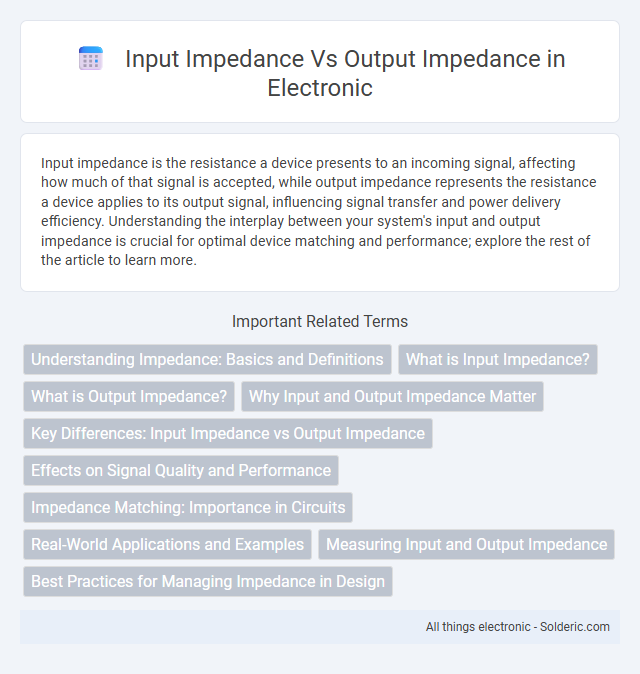Input impedance is the resistance a device presents to an incoming signal, affecting how much of that signal is accepted, while output impedance represents the resistance a device applies to its output signal, influencing signal transfer and power delivery efficiency. Understanding the interplay between your system's input and output impedance is crucial for optimal device matching and performance; explore the rest of the article to learn more.
Comparison Table
| Aspect | Input Impedance | Output Impedance |
|---|---|---|
| Definition | Impedance presented to the source or signal source at the input terminal | Impedance seen by the load at the output terminal of a device |
| Symbol | Zi or Zin | Zo or Zout |
| Units | Ohms (O) | Ohms (O) |
| Importance | Determines how much signal is accepted from the source | Controls how signal is delivered to the load |
| Ideal Value | High (to minimize loading effect on source) | Low (to maximize power transfer to load) |
| Impact on Signal | Limits voltage drop at input, affects signal strength | Controls voltage drop across the load, affects output signal fidelity |
| Typical Usage | Seen in amplifiers, sensors, electrical inputs | Seen in amplifiers, drivers, and output stages |
| Measurement Method | Using signal source and measuring voltage/current at input | Applying load and measuring output voltage/current ratio |
Understanding Impedance: Basics and Definitions
Input impedance refers to the opposition a device presents to incoming signals, determining how much current it draws from the source. Output impedance defines the resistance a device offers to the load it drives, affecting voltage delivery and signal strength. Both impedance values are critical for maximizing signal transfer efficiency and minimizing signal reflection in electronic circuits.
What is Input Impedance?
Input impedance refers to the measure of opposition that a device or circuit presents to incoming electrical signals at its input terminals, typically expressed in ohms (O). It affects how much signal voltage is dropped when entering the device, influencing signal transfer efficiency and overall system performance. Understanding your device's input impedance is crucial for matching it with the source impedance to ensure optimal signal integrity and minimize reflections.
What is Output Impedance?
Output impedance is the measure of the resistance a device presents to the load connected to its output, impacting signal transfer and power delivery. It determines how effectively your audio amplifier or electronic component can drive speakers or subsequent circuits, affecting sound quality and system stability. Lower output impedance generally ensures better performance by minimizing signal loss and distortion in electronic devices.
Why Input and Output Impedance Matter
Input impedance determines how much a device resists incoming signals, affecting signal transfer and preventing signal loss. Output impedance influences the ability of your device to drive the next stage without distortion or power loss. Matching input and output impedance ensures maximum signal integrity and optimal performance in audio, RF, and electronic systems.
Key Differences: Input Impedance vs Output Impedance
Input impedance refers to the resistance a device presents to an incoming signal, impacting how much signal is absorbed or reflected, while output impedance denotes the resistance a device offers to the load it drives, affecting signal delivery efficiency. High input impedance is ideal for minimizing signal loss and ensuring maximum voltage transfer from the source, whereas low output impedance is crucial for driving loads effectively and maintaining signal integrity. Understanding these key differences helps You optimize circuit performance, ensuring proper matching between components for maximum power transfer and minimal distortion.
Effects on Signal Quality and Performance
Input impedance affects how much signal voltage is dropped before processing, with high input impedance minimizing signal loss and maintaining signal integrity. Output impedance determines the ability to drive subsequent stages, where low output impedance ensures better signal transfer and reduces distortion. Matching impedance between stages optimizes signal quality, minimizes reflections, and enhances overall system performance.
Impedance Matching: Importance in Circuits
Impedance matching between input impedance and output impedance is crucial for maximizing power transfer and minimizing signal reflection in electronic circuits. When your circuit's output impedance closely matches the input impedance of the next stage, it ensures efficient signal transmission and reduces distortion. Proper impedance matching improves overall circuit performance, signal integrity, and noise immunity.
Real-World Applications and Examples
Input impedance determines how much a device resists incoming signals, directly affecting signal reception quality in audio and communication equipment. Output impedance influences how efficiently a device can drive the next stage, critical in matching components like amplifiers and speakers for optimal power transfer. In real-world applications, understanding and matching these impedances ensures Your audio system delivers clear sound without distortion or signal loss.
Measuring Input and Output Impedance
Measuring input impedance involves applying a known signal voltage to the input and measuring the resulting current to calculate the ratio of voltage to current at the input terminals, often using an impedance analyzer or LCR meter. Output impedance measurement requires applying a test load resistor to the output and measuring the output voltage with and without the load to determine the voltage drop, which helps calculate the effective output impedance. Understanding the precise values of input and output impedance ensures your circuit or device interfaces correctly with other components, minimizing signal loss and distortion.
Best Practices for Managing Impedance in Design
Designing circuits with matched input and output impedance enhances signal integrity and minimizes reflection losses. Utilizing buffer amplifiers or impedance matching networks can effectively manage disparities between source and load impedances. Careful consideration of impedance values during PCB layout and component selection reduces distortion and ensures optimal performance in high-frequency applications.
Input impedance vs Output impedance Infographic

 solderic.com
solderic.com